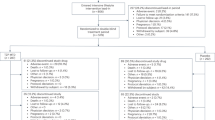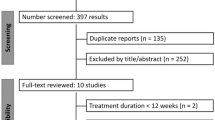Abstract
Objective:
Orlistat and sibutramine are widely prescribed antiobesity agents that are approved for 2 years of continuous use. Previous 1–4-year randomized, placebo-controlled trials of these drugs have reported average weight losses of <5 kg, significant adverse effects and attrition rates of up to 60%. The objective of this study was to determine the long-term persistence with orlistat and sibutramine therapy outside a clinical trial setting.
Design, setting and patients:
Population-based administrative data from British Columbia, Canada, were used to create an inception cohort of orlistat and sibutramine users and determine the 2-year persistence with therapy.
Main outcome measure:
Persistence with therapy at 2 years. Drug discontinuation was defined as the failure to refill a prescription within 120 days. Patients discontinuing therapy were censored at the 60-day mark.
Results:
Nearly 17 000 users of orlistat and 3500 users of sibutramine were identified. For both orlistat and sibutramine, 1-year persistence rates were <10% and 2-year persistence rates were 2%.
Conclusion:
This population-based, retrospective cohort analysis demonstrated very poor long-term persistence rates with orlistat and sibutramine and discontinuation rates that were much higher than those reported in clinical trials.
This is a preview of subscription content, access via your institution
Access options
Subscribe to this journal
Receive 12 print issues and online access
$259.00 per year
only $21.58 per issue
Buy this article
- Purchase on Springer Link
- Instant access to full article PDF
Prices may be subject to local taxes which are calculated during checkout

Similar content being viewed by others
References
Farrigan C, Pang K . From the analysts's couch. Obesity market overview. Nat Rev Drug Discov 2002; 1: 257–258.
Bray GA, Tartaglia LA . Medicinal strategies in the treatment of obesity. Nature 2000; 404: 672–677.
Padwal R, Li SK, Lau DCW . Long-term pharmacotherapy for overweight and obesity: a systematic review and meta-analysis of randomized controlled trials. Int J Obes Relat Metab Disord 2003; 27: 1437–1446.
Medical News Today. Data Demonstrate Impact of Weight Loss with Sibutramine on Cardiovascular Risk Factors for Obese Patients, 2004 (Accessed April 6, 2006 at http://www.medicalnewstoday.com/index.php?newsid=885 ).
Torgerson JS, Hauptman J, Boldrin MN, Sjostrom L . Xenical in the prevention of diabetes in obese subjects (XENDOS) study: a randomized study of orlistat as an adjunct to lifestyle changes for the prevention of type 2 diabetes in obese patients. Diabetes Care 2004; 27: 155–161.
Jackevicius CA, Mamdani M, Tu JV . Adherence with statin therapy in elderly patients with and without acute coronary syndromes. JAMA 2002; 288: 462–467.
Caro JJ, Speckman JL, Salas M, Raggio G, Jackson JD . Effect of initial drug choice on persistence with antihypertensive therapy: the importance of actual practice data. CMAJ 1999; 160: 41–46.
Schneeweiss S, Walker AM, Glynn RJ, Maclure M, Dormuth C, Soumerai SB . Outcomes of reference pricing for angiotensin-converting-enzyme inhibitors. N Engl J Med 2002; 346: 822–829.
Levy AR, O'Brien BJ, Sellors C, Grootendorst P, Willison D . Coding accuracy of administrative drug claims in the Ontario drug benefit database. Can J Clin Pharmacol 2003; 10: 67–71.
Wilkins R . PCCF+ Version 3G User's Guide: Automated Geographic Coding Based on the Statistics Canada Postal Code Conversion Files. Ottawa: Statistics Canada, 2001.
Dailey G, Kim MS, Lian JF . Patient compliance and persistence with antihyperglycemic drug regimens: evaluation of a medicaid patient population with type 2 diabetes mellitus. Clin Ther 2001; 23: 1311–1320.
Blanck HM, Khan LK, Serdula MK . Prescription weight loss pill use among Americans: patterns of pill use and lessons learned from the fen-phen market withdrawal. Prev Med 2004; 39: 1243–1248.
Osterberg L, Blaschke T . Adherence to Medication. N Engl J Med 2005; 353: 487–497.
National Heart, Lung, and Blood Institute Obesity Education Initiative. Clinical guidelines on the identification, evaluation, and treatment of overweight and obesity in adults: the evidence report. Bethesda, MD: U.S. Department of Health and Human Services, Public Health Service, National Institutes of Health, National Heart, Lung, and Blood Institute, 1998; 1–262.
Obesity: the prevention identification, assessment and management of overweight and obesity in adults and children (draft). London, England: National Institute for Health and Clinical Excellence, 2006 (Accessed April 6, 2006 at www.nice.org.uk/page.aspx?o=96572).
Orlistat: summary of product characteristics. London England: European Agency for the Evaluation of Medicinal Products, 2005 (Accessed April 6, 2006 at www.emea.eu.int/humandocs/PDFs/EPAR/Xenical/H-154-PI-en.pdf).
Beermann B, Melander H, Sawe J, Ulleryd C, Dahlqvist R . Incorrect use and limited weight reduction of orlistat (Xenical) in clinical practice. Eur J Clin Pharmacol 2001; 57: 309–311.
Pearson T, Kopin L . Bridging the treatment gap: improving compliance with lipid-modifying agents and therapeutic lifestyle changes. Prev Cardiol 2003; 6: 204–211.
Blood Pressure Lowering Treatment Trialists' Collaboration. Effects of different blood-pressure-lowering regimens on major cardiovascular events: results of prospectively-designed overviews of randomised trials. Lancet 2003; 362: 1527–1535.
Cholesterol Treatment Trialists' Collaborators. Efficacy and safety of cholesterol-lowering treatment: prospective meta-analysis of data from 90 056 participants in 14 randomised trials of statins. Lancet 2005; 366: 1267–1278.
Wooltorton E . Obesity drug sibutramine (Meridia): hypertension and cardiac arrhythmias. CMAJ 2002; 166: 1307–1308.
Health Canada reports back to public on safety profile of MERIDIA (sibutramine). Ottawa Ontario: Health Canada, 2003 (Accessed April 6, 2006 at www.hc-sc.gc.ca/ahc-asc/media/advisories-avis/2003/2003_07_e.html ).
Committee for Proprietary Medicinal Products opinion following an article 31 referral: Sibutramine. London, England: European Agency for the Evaluation of Medicinal Products, 2002 (Accessed April 6, 2006 at www.emea.eu.int/pdfs/human/referral/451401en.pdf).
Swinburn BA, Carey D, Hills AP, Hooper M, Marks S, Proietto J et al. Effect of orlistat on cardiovascular disease risk in obese adults. Diabetes Obes Metab 2005; 7: 254–262.
Foxcroft DR . Orlistat for the treatment of obesity: cost utility model. Obes Rev 2005; 6: 323–328.
Acknowledgements
R Padwal originated the idea for this study and wrote the initial draft. All authors contributed to the study design, interpretation of the data, and critical revision of intermediate and final drafts. A Kezouh performed the statistical analysis, with input from other authors. R Padwal had full access to the data in the study and takes responsibility for the integrity of the data and the accuracy of the analysis. The authors thank the Centre for Health Services and Policy Research and the College of Pharmacists of B.C. for providing data. The opinions expressed herein represent the views of the authors and not the agencies that provided data. This project was not supported by any external funding source and was approved by the ethics panel at the University of Alberta.
Author information
Authors and Affiliations
Corresponding author
Additional information
Note: This paper was presented as an oral presentation at the International Congress of Obesity in Sydney, Australia in September 2006
Rights and permissions
About this article
Cite this article
Padwal, R., Kezouh, A., Levine, M. et al. Long-term persistence with orlistat and sibutramine in a population-based cohort. Int J Obes 31, 1567–1570 (2007). https://doi.org/10.1038/sj.ijo.0803631
Received:
Revised:
Accepted:
Published:
Issue Date:
DOI: https://doi.org/10.1038/sj.ijo.0803631
Keywords
This article is cited by
-
Role of obesity related inflammation in pathogenesis of peripheral artery disease in patients of type 2 diabetes mellitus
Journal of Diabetes & Metabolic Disorders (2023)
-
Liraglutide and the management of overweight and obesity in people with severe mental illness: qualitative sub-study
BMC Psychiatry (2022)
-
Liraglutide and the management of overweight and obesity in people with schizophrenia, schizoaffective disorder and first-episode psychosis: protocol for a pilot trial
Trials (2019)
-
Pharmacotherapy of Obesity: Clinical Trials to Clinical Practice
Current Diabetes Reports (2017)
-
The effect of sibutramine prescribing in routine clinical practice on cardiovascular outcomes: a cohort study in the United Kingdom
International Journal of Obesity (2015)



